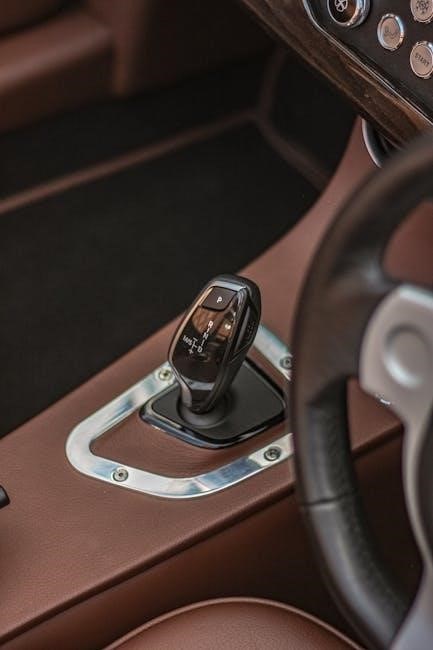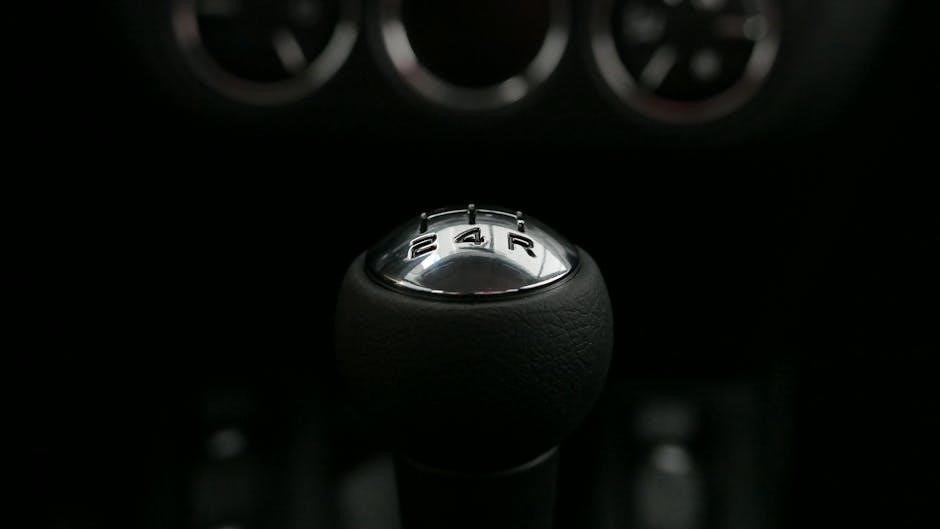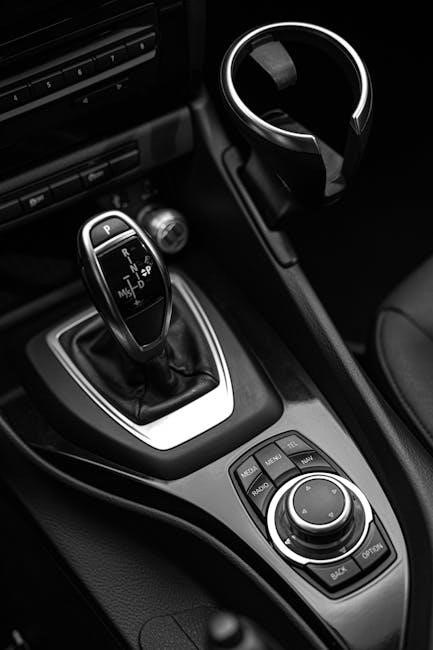
three speed manual transmission
A three-speed manual transmission is a type of gearbox with three forward gears‚ offering simplicity and durability. It connects the engine to the drivetrain‚ requiring clutch and gearshift engagement for operation.
What is a Three-Speed Manual Transmission?
A three-speed manual transmission is a type of gearbox that provides three forward gear ratios for vehicle propulsion. It operates through a manual clutch and gearshift‚ requiring driver input to change gears. This system is mechanically simple‚ with a gearset‚ shafts‚ and synchronizers enabling smooth gear transitions. The transmission connects the engine to the drivetrain‚ allowing the driver to control speed and torque. Three-speed manuals are known for their durability and ease of maintenance‚ making them a popular choice for classic cars‚ trucks‚ and older vehicles. They are often preferred for their straightforward design and fuel efficiency in urban and light-duty driving conditions. Understanding its operation and components is essential for drivers who want to master manual shifting techniques and maintain optimal performance. This transmission type remains a staple in automotive history‚ offering a blend of simplicity and functionality.
Importance of Understanding Manual Transmissions
Understanding manual transmissions‚ particularly three-speed systems‚ is crucial for drivers seeking control over their vehicle’s performance. Manual transmissions offer better fuel efficiency‚ lower maintenance costs‚ and enhanced driving engagement compared to automatics. They also provide a deeper connection to the mechanics of the car‚ allowing drivers to optimize gear usage for varying driving conditions. Additionally‚ diagnosing and repairing issues in manual transmissions is often simpler due to their mechanical simplicity. This knowledge is especially valuable for classic car enthusiasts and those preferring a more hands-on driving experience. Moreover‚ understanding manual transmissions can improve driving skills‚ reduce wear on components‚ and extend the lifespan of the vehicle. It empowers drivers to make informed decisions about their car’s maintenance and operation‚ making it a worthwhile skill to acquire for any automotive enthusiast.

History and Evolution
The three-speed manual transmission emerged in the early 20th century‚ evolving from non-synchronous to synchronous designs‚ and played a pivotal role in the automotive industry’s development.
Early Development of Manual Transmissions
The development of manual transmissions began in the late 19th century‚ with early systems relying on non-synchronous gear engagement. These primitive designs were cumbersome and required double-clutching to shift gears smoothly. By the early 20th century‚ the three-speed manual transmission emerged as a significant innovation. It featured a clutch pedal and a gearshift‚ becoming a standard in early automobiles. The simplicity of three-speed designs made them accessible for mass production‚ contributing to the widespread adoption of manual transmissions in cars and trucks. Early models were often heavy and required precise driver input‚ but they laid the foundation for modern manual transmissions. The shift from non-synchronous to synchronous designs marked a turning point‚ improving ease of use and reliability. This era of development was crucial for the automotive industry‚ paving the way for more advanced transmission systems.
The Rise of Three-Speed Transmissions in Automotive History
The three-speed manual transmission gained prominence in the early 20th century‚ becoming a cornerstone of automotive development. Its simplicity and durability made it an ideal choice for mass-produced vehicles‚ such as the Ford Model T‚ which popularized the design. By the 1920s‚ three-speed transmissions were standard in most cars‚ offering drivers better control and fuel efficiency compared to earlier single- or two-speed systems. The transmission’s reliability and ease of maintenance solidified its reputation‚ making it a favorite among both manufacturers and drivers. This period marked the heyday of three-speed manuals‚ as they became synonymous with affordable and practical transportation. Their widespread adoption played a pivotal role in shaping the automotive industry‚ setting the stage for future innovations in transmission technology.

Key Components of a Three-Speed Manual Transmission
The three-speed manual transmission consists of the gearset‚ shafts‚ clutch‚ pressure plate‚ shift forks‚ synchronizers‚ and transmission housing‚ each playing a vital role in its operation.
Gearset and Shaft Design
The gearset in a three-speed manual transmission includes three forward gears and one reverse gear‚ mounted on input‚ output‚ and countershaft assemblies. The gearset is designed to provide optimal torque and speed ratios for various driving conditions. The shafts‚ typically made of high-strength steel‚ are precision-engineered to ensure smooth power transmission. The input shaft connects to the clutch‚ while the output shaft links to the driveshaft‚ delivering power to the wheels. Bearings and bushings are used to reduce friction and wear during operation. The gear teeth are cut with precise angles and spacing to ensure proper meshing and minimize noise. The shafts are also designed with splines to securely engage gears during shifting. This robust design ensures durability and reliable performance under varying loads.
Clutch and Pressure Plate Mechanism
The clutch and pressure plate mechanism is essential for engaging and disengaging the engine from the transmission in a three-speed manual transmission. The clutch disc‚ sandwiched between the pressure plate and the flywheel‚ connects the engine to the transmission when engaged. Pressing the clutch pedal disengages the disc‚ allowing gear changes without grinding. The pressure plate applies constant force to maintain contact when the clutch is engaged. The release bearing moves the pressure plate away from the clutch disc when the pedal is pressed‚ enabling smooth shifts. Proper alignment and adjustment of these components are critical for smooth operation. Over time‚ wear on the clutch disc or pressure plate can lead to slipping or difficulty engaging gears‚ requiring replacement to maintain performance.
Shift Forks and Synchronizers
Shift forks and synchronizers are critical components in a three-speed manual transmission‚ ensuring smooth and precise gear engagement. Shift forks‚ typically connected to the gear lever‚ move the gears along the shaft to engage or disengage them. Synchronizers‚ located between gears‚ align the rotational speed of the input shaft with the gear being selected‚ preventing grinding during shifts. When the driver presses the clutch and moves the gear lever‚ the shift fork activates the synchronizer‚ which meshes the desired gear. The synchronizer’s teeth and springs help in locking the gear into place once aligned. Proper lubrication and alignment of these components are essential for smooth operation. Over time‚ wear on synchronizers or shift forks can lead to difficulty in shifting gears‚ requiring replacement to maintain transmission performance and prevent damage.

Transmission Housing and Mounting
The transmission housing serves as the structural backbone of the three-speed manual transmission‚ enclosing the internal components and providing a rigid framework for operation. Typically constructed from durable materials like cast iron or aluminum‚ the housing ensures strength while minimizing weight. The mounting system‚ including brackets and rubber isolators‚ secures the transmission to the vehicle’s chassis or engine‚ absorbing vibrations and reducing noise. Proper alignment of the housing during installation is crucial to prevent uneven wear on internal components. The housing also includes ports for lubrication and cooling‚ essential for maintaining optimal operating temperatures. Over time‚ excessive wear on mounts or misalignment can lead to vibrations and transmission damage‚ highlighting the importance of regular inspections and maintenance. The housing and mounting system play a vital role in ensuring the transmission’s reliability and performance under various driving conditions.

How a Three-Speed Manual Transmission Works
A three-speed manual transmission enables drivers to manually switch gears via a clutch and gearshift. Pressing the clutch disengages the engine‚ allowing gear changes. The synchronizers ensure smooth transitions between the three forward gears and reverse. As the driver accelerates‚ they coordinate clutch release with accelerator input for seamless power delivery. This system relies on mechanical engagement and driver input to optimize speed and torque for varying driving conditions‚ providing control and efficiency.
Mechanical Operation of Gears and Shift Mechanism
In a three-speed manual transmission‚ the mechanical operation involves the interaction of gears‚ shafts‚ and shifting components. The gearset includes three forward gears and one reverse gear‚ mounted on input and output shafts. The input shaft is connected to the engine‚ while the output shaft transmits power to the driveshaft. The shift mechanism‚ operated by the gearshift‚ uses shift forks to engage or disengage gears on the shafts. When the driver moves the gearshift‚ it activates the forks‚ sliding them to mesh the desired gear with the shaft. The detent mechanism ensures the gearshift stays in position‚ securing the gear engagement. This mechanical process relies on precise alignment and driver input to smoothly transition between gears‚ providing control over speed and torque delivery.
Role of the Clutch in Gear Engagement
The clutch plays a critical role in gear engagement by interrupting power transmission between the engine and the transmission. When the driver presses the clutch pedal‚ it disengages the clutch from the flywheel‚ allowing the transmission to shift gears without engine resistance. The clutch consists of a friction plate‚ pressure plate‚ and release bearing. Pressing the pedal activates the release bearing‚ which moves the pressure plate away from the friction plate‚ breaking the connection. This temporary disconnection enables smooth gear changes by preventing grinding or damage to the gears. Releasing the pedal re-engages the clutch‚ restoring power to the transmission. Proper clutch control is essential for seamless shifting‚ as abrupt or incomplete disengagement can lead to wear or component failure. The clutch ensures efficient and controlled gear transitions‚ making it indispensable in manual transmissions.

Synchronizer Function in Smooth Shifting
Synchronizers play a crucial role in enabling smooth gear transitions in a three-speed manual transmission. These components are designed to align the rotational speed of the gearset with the desired gear‚ ensuring a seamless shift. When the driver moves the shift lever‚ the synchronizer engages with the target gear‚ bringing it to the same speed as the transmission input shaft. This synchronization prevents gear clashing and ensures a smooth engagement. The synchronizer mechanism typically consists of a hub‚ sleeves‚ and blocking rings. As the gear is selected‚ the synchronizer locks onto it‚ aligning their speeds and facilitating a quiet‚ jerk-free shift. This function reduces wear on the gears and enhances the overall driving experience by making shifts more fluid and less physically demanding for the driver.

Driving Techniques with a Three-Speed Manual
Mastering the three-speed manual transmission involves smooth acceleration‚ precise clutch control‚ and timely gear shifts. Drivers should listen to engine RPMs to optimize performance‚ minimize wear‚ and handle various driving conditions effectively.
Basic Shifting Techniques
Mastering basic shifting techniques is essential for driving a three-speed manual transmission. Start by fully pressing the clutch pedal before moving the gearshift to avoid grinding gears. Always use the clutch pedal smoothly and avoid riding it‚ as this can wear down components. Shift into first gear while stationary‚ then gradually release the clutch as you press the accelerator to start moving. For higher gears‚ press the clutch‚ move the shift lever to the desired gear‚ and release the clutch slowly while accelerating. Downshift before slowing down to maintain control and avoid braking unnecessarily. Pay attention to engine RPMs to determine the appropriate gear for the speed. Proper coordination between the clutch‚ accelerator‚ and gearshift ensures smooth and efficient driving. Practice in a safe‚ open area to build muscle memory and confidence. Avoid common mistakes like skipping gears or forcing the shift lever into place.
Acceleration and Deceleration Strategies
Effective acceleration and deceleration strategies are crucial for optimal performance with a three-speed manual transmission. When accelerating‚ press the clutch smoothly and shift through the gears progressively‚ ensuring the engine RPM matches the vehicle speed. Shift into higher gears as the car gains momentum‚ avoiding excessive revving. Downshift before decelerating to maintain control and reduce brake wear. Use engine braking by shifting to lower gears when approaching stops or descending hills. Coordinate clutch release with accelerator input for seamless acceleration. Avoid sudden shifts‚ as they can disrupt traction. For deceleration‚ downshift gradually to slow down naturally. Proper use of gears during acceleration and deceleration enhances fuel efficiency‚ reduces wear on components‚ and improves overall driving experience. Practice these techniques to master smooth transitions and maintain control in various driving conditions.
Tips for Smooth Gear Engagement
Smooth gear engagement in a three-speed manual transmission requires precise coordination between the clutch‚ accelerator‚ and shift lever. Always press the clutch fully before shifting to avoid grinding gears. Use a smooth‚ gradual release of the clutch while pressing the accelerator to maintain control and prevent jerking. Avoid “riding the clutch‚” as this can wear out the clutch and pressure plate. When shifting‚ ensure the gear is fully engaged before releasing the clutch. Double-clutching can help in smooth shifting‚ especially when downshifting. Always match the gear to the vehicle’s speed and load. Use the clutch and accelerator simultaneously for seamless transitions. Practice in a safe‚ open area to develop muscle memory and timing. Proper technique enhances performance‚ reduces wear on components‚ and improves overall driving efficiency. Consistent practice leads to smoother and more confident gear changes.

Applications of Three-Speed Manual Transmissions
Three-speed manual transmissions are commonly used in classic cars‚ trucks‚ and vintage vehicles due to their simplicity and durability. They are also found in early racing cars and heavy-duty applications‚ providing reliable performance in various driving conditions.
Use in Classic Cars and Vintage Vehicles
Three-speed manual transmissions are widely associated with classic cars and vintage vehicles‚ particularly those from the mid-20th century. Their simplicity‚ durability‚ and lightweight design made them ideal for smaller engines and compact cars. Many iconic models‚ such as early Ford‚ Chevrolet‚ and Volkswagen Beetles‚ relied on three-speed manuals for reliable performance. These transmissions were also popular in European economy cars‚ offering smooth gear engagement and fuel efficiency. Classic car enthusiasts often prefer three-speed manuals for their mechanical connection to the driving experience. Additionally‚ their ease of maintenance and repair has made them a favorite among restorers of vintage vehicles. The nostalgic appeal and affordability of these transmissions continue to make them a staple in the classic car community‚ ensuring their legacy endures in the world of automotive history and collectibility.
Three-Speed Transmissions in Trucks and Heavy-Duty Vehicles
Three-speed manual transmissions were commonly used in trucks and heavy-duty vehicles during the mid-20th century‚ particularly for their durability and simplicity. These transmissions were well-suited for work vehicles‚ as they provided reliable torque delivery and straightforward maintenance. Early models‚ such as the Ford F-Series and Chevrolet trucks‚ often featured three-speed manuals‚ which were ideal for hauling and towing. The mechanical simplicity of these transmissions made them robust and less prone to failure under heavy loads. However‚ as trucks evolved to require more gears for better fuel efficiency and performance‚ the three-speed manual gradually gave way to four-speed and higher transmissions. Despite this‚ three-speed manuals remain a testament to the practicality and strength of earlier automotive engineering in heavy-duty applications.
Role in Early Racing and Performance Cars
Three-speed manual transmissions played a significant role in early racing and performance cars‚ offering a balance of simplicity‚ durability‚ and mechanical efficiency. Their compact design and lightweight construction made them ideal for high-performance applications‚ where reducing overall vehicle weight was crucial. Early sports cars‚ such as the MG T-Series and Triumph TR models‚ often utilized three-speed manuals to deliver quick acceleration and precise control. The direct mechanical connection between the driver and the engine allowed for better throttle response‚ which was advantageous in competitive racing environments. Additionally‚ the fewer moving parts compared to modern transmissions reduced the risk of mechanical failure under extreme conditions. Although later replaced by four-speed and five-speed units‚ the three-speed manual transmission left a lasting legacy in the development of performance vehicles‚ proving that simplicity could coexist with speed and agility.

Advantages and Disadvantages
A three-speed manual transmission offers simplicity‚ lower cost‚ and reliability but lacks the flexibility and performance of modern multi-speed units‚ making it less efficient for diverse driving conditions.
Benefits of Three-Speed Manuals
A three-speed manual transmission offers several benefits‚ including simplicity in design‚ lower production costs‚ and reduced maintenance needs compared to modern multi-speed units. Its straightforward gearset and fewer components result in higher reliability and durability‚ making it a practical choice for older or lightweight vehicles. Fuel efficiency is enhanced in specific driving conditions‚ particularly in urban environments or for vehicles with smaller engines‚ as the gearing is optimized for lower-speed operations. Additionally‚ the lightweight nature of three-speed transmissions improves the overall power-to-weight ratio of a vehicle‚ contributing to better acceleration and responsiveness. For drivers who enjoy a more hands-on connection to their vehicle‚ the simplicity of a three-speed manual provides a satisfying driving experience with clear and direct gear engagement feedback.
Limitations and Challenges
Three-speed manual transmissions have several limitations that have contributed to their decline in modern automotive applications. One major drawback is the lack of flexibility in gear ratios‚ which can lead to less efficient fuel consumption‚ especially at higher speeds or when driving in hilly terrain. The larger gaps between gears can result in a less smooth driving experience compared to transmissions with more gear options. Additionally‚ the increased driver effort required for frequent shifting in stop-and-go traffic can be tiring and less convenient than automatic or modern manual transmissions with more gears. Furthermore‚ the mechanical simplicity of three-speed transmissions limits their compatibility with advanced driver-assistance systems and modern engine technologies. Maintenance and repair can also become challenging as parts and expertise for older transmissions become scarce. Overall‚ while three-speed manuals offer simplicity and durability‚ their limitations in performance‚ efficiency‚ and convenience make them less practical for contemporary driving needs.

Maintenance and Repair
Regular checks‚ fluid inspections‚ and timely part replacements are essential. Addressing worn components early prevents major damage. Professional expertise is often required for complex repairs.
Regular Maintenance Checks
Regular maintenance is vital to ensure the longevity and performance of a three-speed manual transmission. Owners should inspect the transmission fluid level and condition‚ checking for signs of contamination or degradation. Leaks around the transmission housing‚ seals‚ and gaskets should be addressed promptly to prevent fluid loss. The clutch system‚ including the clutch cable or hydraulic system‚ must be checked for proper alignment and wear. Professionals recommend inspecting the gearshift mechanism for smooth operation and adjusting it if necessary. Additionally‚ the transmission mounts should be examined for cracks or looseness to maintain proper alignment. Regular listening for unusual noises during gear shifts can help identify potential issues early. By adhering to a consistent maintenance schedule‚ drivers can prevent costly repairs and maintain optimal performance of their three-speed manual transmission.
Common Repairs and Troubleshooting
Common repairs for three-speed manual transmissions often involve addressing worn or damaged components. Grinding gears‚ for instance‚ may indicate worn synchronizers or clutch issues. Leaks from the transmission housing or seals are frequent and require immediate attention to prevent fluid loss. The clutch assembly is another area prone to wear‚ with symptoms like slipping or failure to engage gears. Noisy operation‚ such as whining or clunking sounds‚ can signal worn bearings or gear teeth. Troubleshooting typically involves inspecting the clutch‚ checking transmission fluid levels‚ and examining gear engagement. In severe cases‚ rebuilding or replacing the gearset may be necessary. Early detection of these issues is crucial to avoid costly overhauls. Regular inspection and timely repairs ensure the transmission operates smoothly and efficiently‚ maintaining its durability over time;